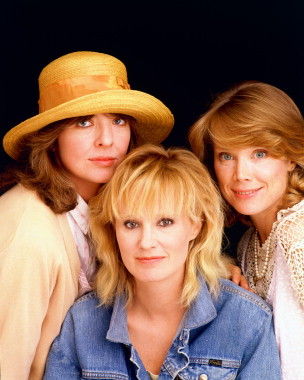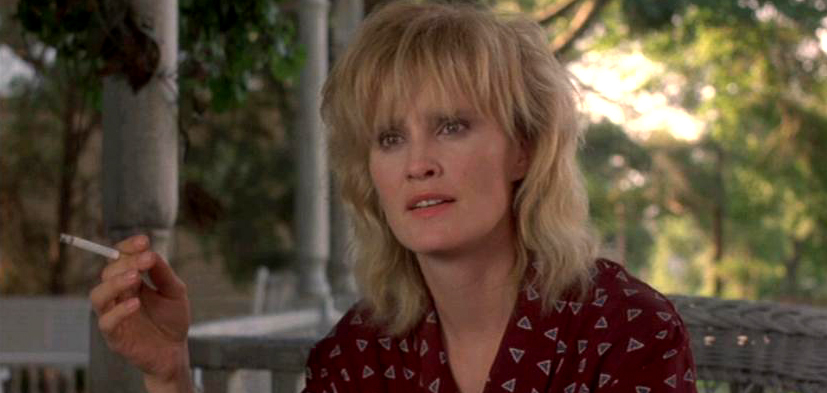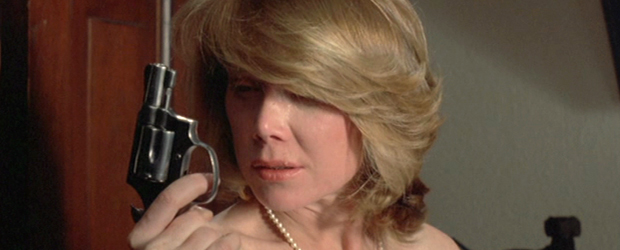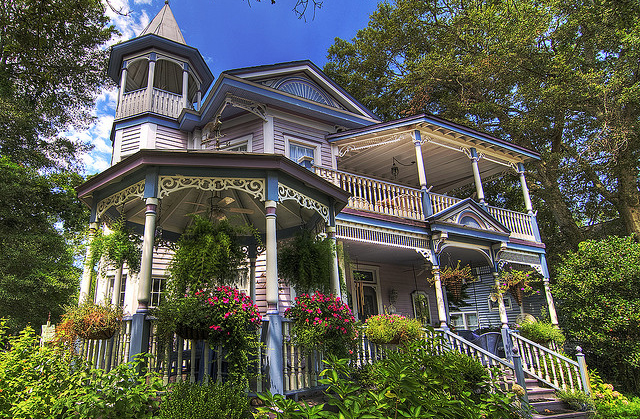 Kurt here from Your Movie Buddy.
Kurt here from Your Movie Buddy.
Crimes of the Heart is for people who love Steel Magnolias, who can't bring themselves to change the channel when The First Wives Club plays on cable, and who can't resist a small handful of emotive, big-name actresses playing off each other courtesy of a witty, womanly text. Now that I have the attention of what I'll dare to guess is about 89 percent of you, allow me to resurrect this twangy, dysfunctional black comedy, which turns 25 this year. Directed by Bruce Beresford (Tender Mercies, Driving Miss Daisy), it's one of those films whose title is so generic you'd swear you've seen it a dozen times, and yet its drop into the proverbial cracks has all but erased your knowledge/memory of it.
The film's official release-date birthday isn't until Dec. 12, but it's fresh in my mind because I just caught a fine stage rendition of playwright/screenwriter Beth Henley's source material – a Pulitzer Prize-winning work that draws its power from Henley's keen ability to mash the comic and the tragic with the frequent spikes and dips of a heart monitor (think Rachel Getting Married with more irony and fewer shattering tears). The story takes place in Hazlehurst, Miss., where the MaGrath sisters – Babe, Lenny and Meg – are reuniting at their childhood home under characteristically eccentric circumstances. Babe, the youngest, just got out of jail for shooting her husband in the stomach (she “didn't like his stinkin' looks”). Lenny, the melancholic eldest, just turned 30 and is nursing her pent-up sexual frustration with cookies and self pity (a shrunken-ovary problem makes her think she's useless to men). Meg, the rebel, has returned from L.A. with nothing to show for her singing-career ambitions but the after-effects of a nervous breakdown.
 What's more, Lenny's horse was just struck dead by lightning, nosy and pushy cousin Chick is nagging outside the screen door, the girls' granddaddy/surrogate father is ailing in the hospital, and then there's the memory of the suicide of their mother, who, years ago, hung herself along with the family cat. You get the picture.
What's more, Lenny's horse was just struck dead by lightning, nosy and pushy cousin Chick is nagging outside the screen door, the girls' granddaddy/surrogate father is ailing in the hospital, and then there's the memory of the suicide of their mother, who, years ago, hung herself along with the family cat. You get the picture.
At first, it seems this movie – which is available to watch in its entirety on YouTube, btw – doesn't have much to offer in regards to justifying the play being committed to film. Despite its undeniable retro charm, the Plain-Jane opening is super indicative of the film's subsequent obscurity, from its credits (which could make a Power Point presentation look masterful) to its score (best described as low-rent Kenny G.). It doesn't take long, however, for the hooks to dig in. Turns out Crimes is quite the watchable little gem, thanks mainly to its four lead stars: Diane Keaton, Jessica Lange, Sissy Spacek and a marvelous, neglected old Victorian that serves as the tack-tacular setting.
Diane Keaton as Lenny

The actress who portrayed Lenny in the stage version I saw was by far the funniest cast member because she was able to nail her character's emotional volatility and spastic, hysterical neuroses. Naturally, this is a role for Diane Keaton...
Keaton, Lange and Sissy's Oscar-nominated work after the jump.
At the risk of validating certain claims that Diane Keaton is rather one-note, it is remarkable how similar her performance in Crimes is to numerous future performances. I highlight this out of love, I assure you: Lenny is a precursor to Erica in Something's Gotta Give (a confessed neurotic), Bessie in Marvin's Room (another frumpy recluse caring for a sick old man), Georgia in Hanging Up (another film about a trio of sisters caring for, yes, a sick old man) and Annie in The First Wives Club. The latter, in my mind, is the closest connection in terms of character personality. To get an accurate idea of the high point of Keaton's Crimes performance, you need only think back to the high point of her turn in Wives: “I though we were supposed to helping each other, not ripping each other to SHREDS!!!”
Jessica Lange as Meg

The role of Meg requires a certain sexual power that's not slutty, per se, but coyly authoritative. Again, the casting is spot-on with Jessica Lange, who's both damaged and intimidating in her performance, a highly enjoyable mix of knowing glances, devilish laughs and devil-may-care posture. Meg's habits include taking a bite out of every chocolate in a box then putting them back, trimming the bangs of her straw-blonde hair with a Bic razor, and never being without a cigarette between her fingers (a performance peak is when she's confronted by cousin Chick, played by Tess Harper, about the dangers of smoking: “I love the power,” she says lustfully, “taking a drag off of death – you want a drag?”). With that wicked streak always brewing beneath Meg's sisterly kindnesses, I was reminded of both Lange's deliciously menacing turn in Julie Taymor's Titus and, with the southern accent and all, her role as Gwyneth Paltrow's (very) wicked stepmother in Hush.
You bad girl, you found me out, didn't you?
Sissy Spacek as Babe

I'm no Sissy expert (the one I know best is the one who gets slap-happy when Marisa Tomei is in the room), but I know enough to gather that Crimes draws on the appeal of Princess Sissy, a persona earned, of course, from a certain unforgettable prom appearance. As Babe, she is the delicate flower of this film – the prettiest and daintiest thing on screen. But that, like I said, is all part of a persona – she's in fact capable of murder, a bit suicidal and – spoiler alert! – prone to interracial and pedophilic affairs. The actress I saw on stage got Babe all wrong – she was too young, too shrill and too lacking in comedic nuance. Sissy seems like she could easily be the definitive Babe. She embodies the character, who herself is the embodiment of the text's tone: innocent, but brutal; sweet, but sour. It's no wonder Babe likes extra lemon and extra sugar in her lemonade.
This Old House
 Finally, the glorious structure that acts as the movie's stage is an old Victorian beauty that lies somewhere in North Carolina. The image I've provided is in fact the house in question; however, its condition in the film is nowhere near pristine. Outside, paint is chipping and dead vines abound. Inside, there's an amazing nightmare of tacky décor, from brass chandeliers to factory-produced stained glass to gingerbread woodwork above every single archway. It's a beautiful beast of a shooting space, and DP Dante Spinotti (L.A. Confidential) offers unbroken takes up the stairs and through rooms as we follow the sisters from one literally cluttered crisis to the next. Though its nowhere near so off-the-charts outrageous, the house reminded me of the production design of She-Devil, the high priestess of gaudy decadence. The mix of patterns and textures, which spills over into the sisters' wardrobes, makes it a sort of inhabitable time capsule of bad taste. It's fabulous.
Finally, the glorious structure that acts as the movie's stage is an old Victorian beauty that lies somewhere in North Carolina. The image I've provided is in fact the house in question; however, its condition in the film is nowhere near pristine. Outside, paint is chipping and dead vines abound. Inside, there's an amazing nightmare of tacky décor, from brass chandeliers to factory-produced stained glass to gingerbread woodwork above every single archway. It's a beautiful beast of a shooting space, and DP Dante Spinotti (L.A. Confidential) offers unbroken takes up the stairs and through rooms as we follow the sisters from one literally cluttered crisis to the next. Though its nowhere near so off-the-charts outrageous, the house reminded me of the production design of She-Devil, the high priestess of gaudy decadence. The mix of patterns and textures, which spills over into the sisters' wardrobes, makes it a sort of inhabitable time capsule of bad taste. It's fabulous.
Need another reason to catch up with this movie? You're so greedy! How about this: Crimes was nominated for three 1986 Oscars: Best Actress for Sissy, Best Supporting Actress for Harper and Best Adapted Screenplay for Henley.